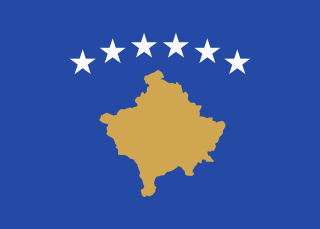
Kosovo, officially the Republic of Kosovo, is a country in Southeast Europe with partial diplomatic recognition. Kosovo lies landlocked in the centre of the Balkans, bordered by Serbia to the north and east, North Macedonia to the southeast, Albania to the southwest, and Montenegro to the west. Most of central Kosovo is dominated by the vast plains and fields of Metohija and the Kosovo field. The Accursed Mountains and Šar Mountains rise in the southwest and southeast, respectively. Its capital and largest city is Pristina.
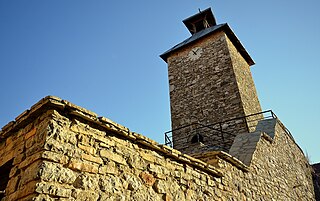
Rahovec or Orahovac, is a town and municipality located in the District of Gjakova in western Kosovo. According to the 2011 census, the town of Rahovec has 15,892 inhabitants, while the municipality has 56,208 inhabitants.

Peja is the fourth most populous city in Kosovo and serves as the seat of the Peja Municipality and the District of Peja. It is located in the Rugova region on the eastern section of the Accursed Mountains along the Lumbardhi i Pejës River in the western part of Kosovo.

The Kosovo Force (KFOR) is a NATO-led international peacekeeping force in Kosovo. Its operations are gradually reducing until Kosovo's Security Force, established in 2009, becomes self-sufficient.
Llap Region is a region located in the north-eastern part of Kosovo. Llap in the broadest sense includes the watershed of the Llapi River. The Llapi water collection begins in the mountains of Kopaonik in the north and west and its source is considered to be the village of Pollatë, and ends by joining the Sitnica river in Lumadh, municipality of Vushtrri, in the north-west of Pristina. The topographic watershed of the Llapi River covers an area of 945.4 km2 (365.0 sq mi).

Istog or Burim is a town and municipality located in the District of Peja of western Kosovo. According to the 2011 census, the city of Istog has 5,115 inhabitants, while the municipality has 39,289 inhabitants. Based on the population estimates from the Kosovo Agency of Statistics in 2016, the municipality has 39,982 inhabitants.

Kaçanik or Kačanik, is a town and municipality located in the Ferizaj District of southern Kosovo. According to the 2011 census, the town of Kaçanik has 15,634 inhabitants, while the municipality has 33,409 inhabitants.

Adem Jashari was one of the founders of the Kosovo Liberation Army (KLA), a Kosovo Albanian separatist militia which fought for the secession of Kosovo from the Federal Republic of Yugoslavia during the 1990s.

Leposavić, also known as Leposaviq or Albanik, is a town and the northernmost municipality in the Mitrovica District in Kosovo. As of 2015, it has an estimated population of 18,600 inhabitants. The municipality covers an area of 539 km2 (208 sq mi) which makes it the fifth largest in Kosovo, and consists of the town and 72 villages.
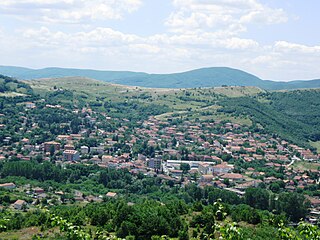
Zvečan or Zveçan is a town and municipality located in the Mitrovica District in Kosovo. As of 2015, it has a population of 16,650 inhabitants. It covers an area of 122 km2 (47 sq mi), and consists of a town and 35 villages.

Zubin Potok is a town and municipality located in the Mitrovica District in Kosovo. As of 2015, it has an estimated population of 15,200 inhabitants. It covers an area of 335 km2 (129 sq mi), and consists of the main town and 63 villages.
Obiliq is a town and municipality in Kosovo. According to the Kosovo Agency of Statistics (KAS) estimate from the 2011 census, there were 21,549 people residing in Obiliq Municipality, with Kosovo Albanians constituting the majority of the population.
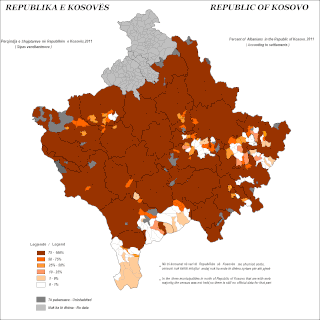
The Albanians of Kosovo, also commonly called Kosovo Albanians, Kosovan Albanians or Kosovars, constitute the largest ethnic group in Kosovo.

Drenica, also known as the Drenica Valley, is a hilly region in central Kosovo, covering roughly around 700 square kilometres (270 sq mi) of Kosovo's total area (6%). It consists of two municipalities, Drenas and Skenderaj, and several villages in Klina, Zubin Potok, Mitrovica and Vushtrri. It is located west of the capital, Pristina.

The municipalities and cities are the second level administrative subdivisions of Serbia. The country is divided into 145 municipalities and 29 cities, forming the basic level of local government.

Skenderaj or Srbica is a town and municipality located in the Mitrovica District of Kosovo. According to the 2011 census, the town of Skënderaj has 9,372 inhabitants, while the municipality has 50,858 inhabitants.

Azem Bejta, commonly known as Azem Galica, was an Albanian nationalist, resistance fighter and rebel who fought for the unification of Kosovo with Albania. He is known for leading the Kachak Movement against the Kingdom of Yugoslavia.

Numerous war crimes were committed by all sides during the Kosovo War, which lasted from 28 February 1998 until 11 June 1999. According to Human Rights Watch, the vast majority of abuses were attributable to the government of Slobodan Milošević, mainly perpetrated by the Serbian police, the Yugoslav army, and Serb paramilitary units. During the war, regime forces killed between 7,000–9,000 Kosovar Albanians, engaged in countless acts of rape, destroyed entire villages, and displaced nearly one million people. The Kosovo Liberation Army has also been implicated in atrocities, such as kidnappings and summary executions of civilians. Moreover, the NATO bombing campaign has been harshly criticized by human rights organizations and the Serbian government for causing roughly 500 civilian casualties.
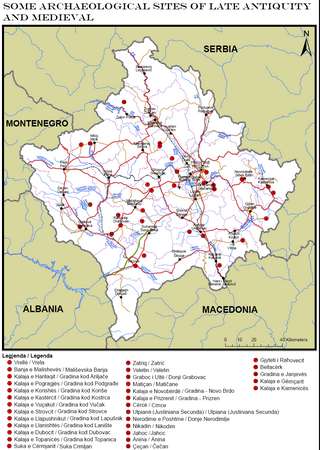
Part of series of articles upon Archaeology of Kosovo
Runik is a village in the Skenderaj municipality of Kosovo. It is located in the Drenica region and has 1,585 inhabitants as of 2011. The village has a football club, KF Përparimi Runik. Runik is the site of an important Neolithic settlement in Kosovo and the wider region. The excavated finds at the site include a baked-clay ocarina, one of the oldest musical instruments which have been in the Balkans and the oldest in Kosovo.


















